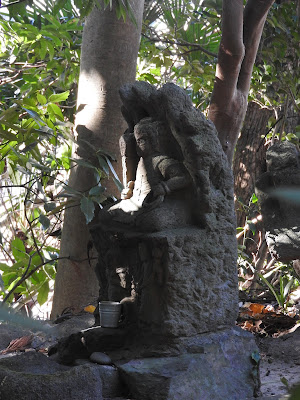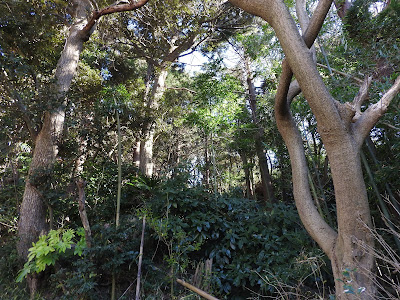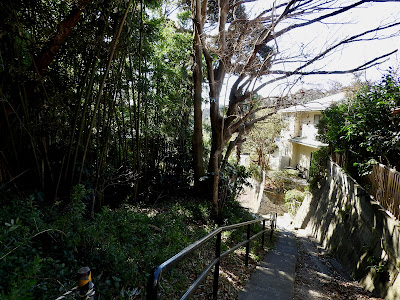目次 / Contents
1) 熊野権現社 / Kumano Gongen Shrine
2) 山の中 / In the Mountain
3) 発見! / Finding!
A. 祠 / Hokora
B.権現像 / Gongen Statue
C. 清掃 / Cleaning
4) さらに登って / Climb Further
A. 登り/ Climb
B. 白い服の女性 / Woman in white clothes
C. 聖福寺谷 / Shofukuji Temple Valley
1) 熊野権現社 / Kumano Gongen Shrine
私と夫Rは、鎌倉山から七里ヶ浜住宅街の正福寺公園 (聖福寺跡) へ
行きました。
最終目的は、"鎌倉海浜公園 (稲村ヶ崎地区)": "稲村ヶ崎公園" ですが、Googleの地図で、正福寺公園近くに、熊野権現社 (クマノゴンゲンシャ) を見つけたので、行ってみることにしたのです。
2019年に私達は、熊野神社の総本山、熊野三山へ行きました。
私が熊野古道を歩きたい!というのがその旅の理由でした。
神仏習合など、以前よりもずっと興味がわきました。
この日、散策の途中に熊野権現社があることを知り、是非とも行きたいと思ったのです。
↓
↓
Kumano Gongen Shrine
I and my husband R walked from Kamakurayama to Shofukuji Temple Park (Shofukuji Temple Site) in the Shichirigahama residential area.
Our final target was "Kamakura Seaside Park (Inamuragasaki District)": "Inamuragasaki Park", but I found Kumano Gongen Shrine near Shofukuji Temple Park on Google's map, so I decided to go there on the way.
and has come to be called Gongen due to the idea of Honji suijaku.
Honji suijaku is one of theories of Shinbutsshūgō which is the
syncretism of Shinto and Buddhism.
The theory is that the Gods in Japan are actually thought to be Gongen of various Buddhas (including Bodhisattva and Tenbe) and they have appeared in Japan as incarnations.
(The group, Kumano Sanzan, is the head office of more than 3,000 Kumano shrines spread all over Japan.)
"The Kumano Kodō (熊野古道) is a series of ancient pilgrimage
These trails were used by pilgrims to
"Kumano Sanzan" (熊野三山) or
the Three Grand Shrines of Kumano:
Kumano Hongū Taisha (熊野本宮大社),
Kumano Nachi Taisha (熊野那智大社) and
Kumano Hayatama Taisha (熊野速玉大社)."
The trip to Kumano made me much more interested in Kumano's Gods, Mountain Worship (one of Nature Worship), Shugendō, and Shinbutsu shūgō.
On this day, I found that there is Kumano Gongen Shrine which we could see on our walk, and I definitely wanted to go there.
About visiting Kumano Sanzan, below.
↓
↓
2) 山の中 / In the Mountain
 |
| 登りが続き、不安になります.... Climbing continues and I feel uneasy .... |
3) 発見! / Finding!
A. 祠 / Hokora
 熊野権現社 神奈川県鎌倉市稲村ガ崎5丁目38 ありました! 見つけた時は、思ったよりも小さな神社で、驚きました。 これは....祠? 可愛い!というのが最初の印象で、なかなか素敵に感じました。 Kumano Gongen Shrine 5-38 Inamuragasaki, Kamakura City, Kanagawa Prefecture Here it is! When I found it, I was surprised by the shrine, which was smaller than I expected. Is this ... a Hokora? Lovely ! That was my first impression, and I felt it was quite good. |
 左から 熊野権現社の碑、権現像、祠 From the Left Kumano Gongen's Monument, Gongen Statue, and Hokora  碑の裏 極楽寺の氏子(ウジ) の方々によって設置されたようなので、 ここは極楽寺の一部だった、もしくは一部なのかもしれません。 ここは極楽寺に近いです。 Back of the Stone Monument It seems that it was set up by Ujiko ; parishioners of Gokurakuji Temple, so this may have been or part of Gokurakuji Temple. This is close to the Temple.  祠 / Hokora According to Wiki about Hokora, "Hokora or hokura (祠 or 神庫) is a miniature Shinto shrine either found on the precincts of a larger shrine and dedicated to folk kami, or on a street side, enshrining kami not under the jurisdiction of any large shrine."  上から 山の中の鳥居なので、コンクリート製です。 木製はすぐに朽ちてしまいます。 From Above Since it is a torii gate in the mountains, it is made of concrete. Wood quickly decays. |
B.権現像 / Gongen Statue
 |
| 権現像 この小さな彫像が好きです。 私には惹かれるものがあります。 剣を持っているので、不動明王 (フドウミョウオウ) を イメージさせます。 不動明王の梵名はアチャラ・ナータ/ Acalanāthaで、 "揺るぎなき守護者"の意味です。 極楽寺は真言宗 (密教) 派なので、不動明王は信仰対象ですし、 修験道の信仰対象も不動明王です。(Wikiより) 不動明王は、この場にふさわしいのでしょう。  Gongen Statue I like this little statue. I find something attracts me. Since it has a sword, it reminds me of Acala : Fudō Myōō. The Sanskrit name of Fudō Myōō is Acalanātha, which means "Unwavering Guardian". Since Gokurakuji Temple is a Shingon Buddhism (Vajrayāna) sect, Fudō Myōō is a religious object, and Shugendō's religious object is also Fudō Myōō (from Japanese Wiki) Fudō Myōō is probably suitable for this occasion.  周囲の環境のせいか、『カンボジア!』という言葉が 頭の中に浮かびました。 私は、カンボジアに行ったことがありません... 不思議な感じ...。 Perhaps because of the surrounding environment, the word "Cambodia!" came to my mind. I have never been to Cambodia ... Mysterious feeling ... |
 |
| 不動明王像 / Acala Statue 画像は下記より / This from below ★ |
C. 清掃 / Cleaning
4) さらに登って / Climb Further
A. 登り/ Climb
 |
| ちょっとしか登っていませんが山の気配は強くなりました。 We have climbed only a little, but the atmosphere of the mountain has become stronger. |
B. 白い服の女性 / Woman in White Clothes
山の中で三叉路に出ました。
1つは極楽寺方面、1つは私達が来た稲村ヶ崎方面、そうしてもう1つは、登りで、けもの道のように細い道でした。
どうしたものか?と考えていると、若い、お洒落な白い服を来た女性が、細い道を下って来ました。
「この道はどこにでるのですか?」
と、私は聞いてみました。
「鎌倉山です」
「鎌倉山?...あっ、もしかしたら、鎌倉山神社の道?」
彼女は笑顔になって
「そうです!私、今、そこから来たのです」
「R、彼女は鎌倉山神社の道から来たのよ」
とRに伝えると彼女は
「私、駅に行きたいのですが、どちら(の道)でしょうか?」
「駅?稲村ヶ崎?極楽寺?」
「極楽寺です」
私は手で私達の来た方をさして
「こちらが稲村ヶ崎です...
だから極楽寺はこっちですね」
と反対の道を示しました。
「私、極楽寺に行きたかったから、こっちですね。ありがとうございました」
「こちらこそ、ありがとうございました」
私は、極楽寺方面に元気に下ってゆく彼女の背中を見つつ、
『こんな山の中を一人で歩くのね〜』
と関心しました。
彼女に何か声をかけたら、よかったかとちょっと後悔。
Rには
「彼女、勇気があるね。一人で山の中を歩けるなんて。
日本だからよね〜」
と言いいました。
Rはうなづき、彼女が来た細い道を突然、登りはじめました!?
え〜っ!
Woman in White Clothes
We reached the three-way junction in the mountain.
One was for Gokurakuji Temple, one was for Inamuragasaki, where we had come from, and the other was a narrow climbing path like a Desire path.
What should we do? while thinking about it, a young, fashionable woman in white clothes came down the narrow path.
"Where is this path going?"
I asked.
"It's Kamakurayama"
"Kamakurayama? ... Oh, maybe the path of Kamakurayama Shrine?"
She smiled,
"Yes! I'm from there now."
I told R,
"R, she came from the path at Kamakurayama Shrine."
and then she asked me,
"I want to go to a station, which (path) is it?"
"Station? Inamuragasaki? or Gokurakuji Temple?"
"Gokurakuij Temple"
I pointed to the path we had come from,
"This is Inamuragasaki ...
That's why Gokurakuji is here. "
I showed the opposite way.
"I wanted to go to Gokurakuji Temple, so this is it. Thank you."
"I say thank to you!"
I looked at her back as she descended toward Gokurakuj Temple.
『You walk alone in such a mountain...』
I was impressed.
I regret that I should have said something for her.
I said to R,
"She has the courage. She can walk alone in the mountains. It's Japan."
R nodded and suddenly began to climb the narrow path she came from!? Wha~t !?
C. 聖福寺谷 / Shofukuji Temple Valley
私がRの後を追うかどうか迷っていると、中年の男性が走って来ました。
彼も細道を登って行きます...それも走って!
私は、山伏の修行を思い起こしました。
もちろん、彼は山伏の格好をしていず、ランナーの服装でしたけれど...。
地元の方にはこの周辺の山道は、よく知られているのでしょう。
Rが戻ってきて、景色の良いことを伝えてくれました。
なので、私も登りました。
稲村ヶ崎住宅街が、谷にそって開けている様子をみることができました。
のちに、この谷が、聖福寺谷 (ショウフクジガヤツ) であることを知りました。
聖福寺跡の石碑に、聖福寺谷のことが書かれていました。
正福寺公園 (聖福寺跡)については下記。
Shofukuji Temple Valley
When I was wondering if I would follow R, a middle-aged man ran.
He also went up the narrow path and that he was running!
I remembered the training of Yamabushi.
According to Wiki about Yamabushi,
"Yamabushi (山伏) (one who prostrates himself on the mountain) are Japanese mountain ascetic hermits.
According to traditional Japanese mysticism, Yamabushi are believed to be endowed with supernatural powers.
They follow the Shugendō doctrine, an integration of mainly esoteric Buddhism of the Shingon sect with Tendai Buddhism, Taoism, and elements of Shinto."
Of course, he wasn't dressed as Yamabushi, he was dressed as a runner ...
The mountain trails around this area are probably well known to the locals.
R came back and told me that the scenery was good.
So I also climbed.
I was able to see the Inamuragasaki residential area opening along a valley.
Later, I found out that this valley is Shofukujigayatsu : Shofukuji Temple Valley.
The valley name : Shofukujigayatsu was written on the stone monument at the site of Shofukuji Temple.
About Shofukuji Temple Park (Shofukuji Temple Site), below.
① 2021年1月20日 散歩・稲村ヶ崎へ - 聖福寺跡 / Take a Walk to
 |
相模湾と谷 / Sagami Bay and Valley |













0 件のコメント:
コメントを投稿